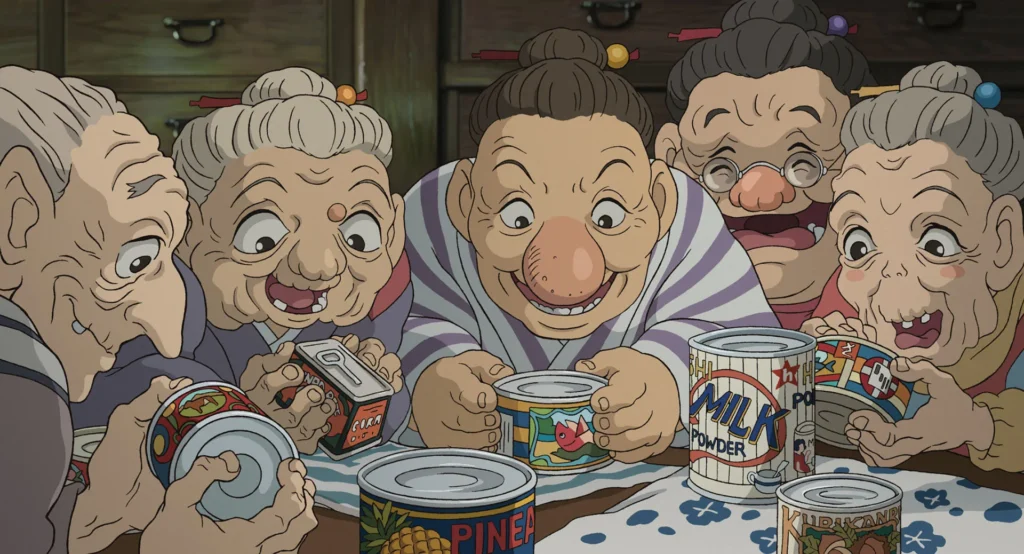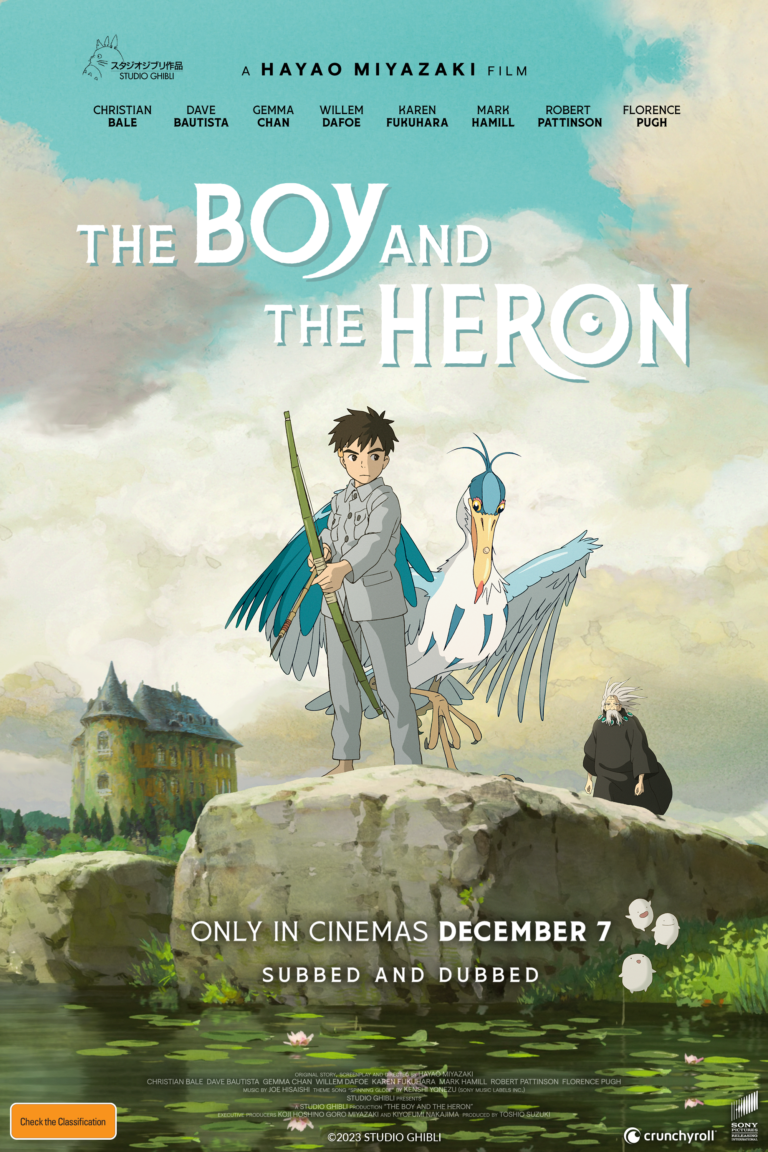The Boy and the Heron – Snapshot
The Boy and the Heron is a beautifully crafted animated feature with a totally confusing storyline. It is confusing because, ultimately, this is Miyazaki’s (the film’s creator) personal understanding of the meaning of his life and upcoming death. How, exactly, are we supposed to participate in that? (3.5*)
Where to Watch:
Stream: (Max)
Rent: Google ($4); Apple/Prime/Fandango ($5)
(Although only rated PG-13, I’m not sure this movie will work well with children. I’m not even sure how well it works with adults…)
The Boy and the Heron – The Oscar Buzz
Oscar Nominations (1) / Oscar Wins (1) :
Animated Feature WINNER
The Boy and the Heron is the brainchild of Hayao Miyazaki, one of the original founders of the Japanese animation company, Studio Ghibli. The Ghibli team has produced a remarkable stream of animated feature films, many of which have received worldwide recognition, including Oscar nominations and wins. Miyazaki’s previous nominees in the Animated Feature category include The Wind Rises (13) and Howl’s Moving Castle (04). And he won the Oscar for Spirited Away (01). Ghibli Studios was founded in 1985 by Miyazaki, Isco Takahata and Toshiba Suzuki. Takahata received an Oscar nomination for his The Tale of Princess Kaguya (15). With almost forty years of history, the Ghibli team includes editors, cinematographers, composers, designers and animators, many of whom have been there a very long time and have worked on many of the studio’s productions.
Their studio is a leader in the Japanese animation style known as anime which is in many ways a takeoff from Japanese graphic comics known as manga with an emphasis on large eyes, detailed settings, and more attention to characters and story than on movement. The Ghibli team focuses almost exclusively on hand-drawn frames and eschew computerized animation. Partly because of the intensive manual effort required to make this film, it took nearly seven years to make. Supposedly, The Boy and the Heron is the most expensive film ever made in Japan.
Hayao Miyazaki wrote the script, directed production, and did significant amount of the animation himself. At the time he accepted the Oscar for this film, earlier this year, he was 83 years old. In short, Miyazaki and Ghibli Studios are legends in the animated film world.
A note should be added about the English-language-dubbed version – which is what you are likely to hear in the U.S. Although I normally don’t like dubbing, the English dialogue, voiced by big-name actors, is far better than the generated on-screen captions. And, of course, unless you speak Japanese, you probably aren’t going to understand the original vocalizations. The actors providing the English dialog include such icons as Christian Bale (Vice, The Big Short, American Hustle, The Fighter, Ford v. Ferrari), Dave Bautista (Drax in the Guardians of the Galaxy Marvel Universe, and Dune), Gemma Chan (Crazy Rich Asians, Raya and the Last Dragon, Mary Queen of Scots), Willem Dafoe (At Eternity’s Gate, The Florida Project, The Lighthouse, Poor Things, Nightmare Alley), Mark Hamill (Luke Skywalker in Star Wars), Robert Pattinson (Twilight Saga, The Batman, Tenet, The Lighthouse) and Florence Pugh (Little Women). Part of the fun for English viewers is to identify all these different and distinct voices!
The Boy and the Heron – Related Movies
Princess Mononoke (97)/Spirited Away (01)/Howl’s Moving Castle (04)/Ponyo (08)/The Wind Rises (13) (Direction, Script, Cinematography, Film Editing, Musical Score, Production Design, Animation)
The Boy and the Heron – What Others Think
The Boy and the Heron was not well received by the viewing public. Overall their ratings placed the film last out of all five animated features and 20th out of all 38 Oscar-nominated movies. Some audience-written reviews include summaries like “Stunning to look at. Just a little hard to follow at times.”; “Just doesn’t do it!”, “A Big Mess” and “Loved the art and the music, hated the story and characters.” The art work wowed everyone; the story left them perplexed and unappreciative.
And, as we might expect, the professional critics raved about the movie, rating it at the top of this year’s Animated Feature nominees and the second best film of the year behind only Past Lives. Critics seemed to focus on the likelihood that this film is Miyazaki’s swan song and is a reflection on his life and mortality. Brian Tallerico (RogerEbert) wrote “it feels like a dream of one of our greatest creators sprung to life” and “This masterful film echoes themes he’s played with his whole life while blending his childlike wonder and a sense of approaching finality.” Alissa Wilkinson (New York Times) gave The Boy and the Heron a Critics Pick and, wrote that it “is enigmatic, at least regarding plot. Better to watch as an exercise in contemplation than storytelling; this is the work of a man pondering life from its endpoint. It’s confounding, meandering through worlds that melt into one another.” Perhaps thinking about mortality comes easier to older critics than it does to families with young children interested in an animated movie for the afternoon!
The critical rating was so high that the overall average rating of the film comes in at sixth out of all 38 movies and behind only the Spider-Man in the animated feature film category.
The Boy and the Heron – Special Mention
Parakeets, Pelicans, and Herons in Japanese Culture – Three types of birds play key roles in The Boy and the Heron and, honestly, I didn’t understand why they were there. So I did what I do with parts of films I don’t get – I did some research. And it turns out that all three birds have figured in Japanese history in some way or another. Most likely Miyazaki chose these three birds to emphasize key themes.
The pelicans in the movie come across as particularly desperate creatures and, in one case, we see a pelican actually dying out. It turns out that pelicans were much more common in Japan in historic times and were seen throughout the island chain. However, probably due to habitat shift, pelicans have literally died out and are now extremely rare except on the island of Sado. Their desperate status is displayed in The Boy and the Heron.
Parakeets, on the other hand, are pretty much as depicted in the movie – aggressive. They are the descendants of pet birds brought over to Japan in the 1960s and 1970s and then let loose. They became feral and are now considered an invasive species. So their behavior in this movie is more a representation of a bird Japan does not particularly like.
As the title of the movie suggests, there is a particular gray heron (although he looks more blue to me) that plays a major, although confusing, role in The Boy and the Heron. I found an article in National Geographic that directly addresses the heron’s role arguing that “the heron has been winging its way into the literature, art, and folklore mythology of Japan for more than a millennium.” Herons have, traditionally, been “tied to spirits, gods, death, and a link to another world.” Apparently Japanese source material as far back as 712, documenting the foundation of Japanese Shinto religion, makes reference to herons being associated with death, funerals, and funeral rights. Although I can’t pretend to decipher the role of the heron in this movie, Miyazaki is clearly referring to a long tradition honoring the heron as a medium between our world, the world of the dead, and the world he anticipates.
The Boy and the Heron – Michael’s Moments
The Boy and the Heron was released in Japan in July, 2023 with no advance publicity except for a simple poster. In notes released at the original release the film’s creator, Hayao Miyazaki wrote “Perhaps you didn’t understand it. I myself don’t understand it.” In other conversations about the film he said “Well, it’s magic. I don’t provide unnecessary explanations. If you want that, you’re not going to like my movie. That’s just the way it is.”
I get some of what he is saying. Miyazaki’s previous “last film” was The Wind Rises which was also nominated for the Animated Feature Film Oscar. It was a terrific film reflecting both his native ability to craft a moving story and his insightful artistic talent in rendering it. But, apparently, that effort left him unsatisfied and unfulfilled. His creative juices weren’t all gone and, in his late 70s, he was facing the end of his reign as a premier storyteller.
And so, over seven years, Miyazaki crafted a new film that speaks to his understanding of his own mortality, of what comes next, and what he can possibly leave to this world. As he has said on multiple occasions, this movie cannot be explained and can’t be made sense of. It is an expression of his sentiments about his own death and what that means for him and those he leaves behind. It is intentionally confounding to the viewers because death is intrinsically confounding to those facing it.
The Boy and the Heron is virtually critic-proof. And what I mean by that is that while we can comment on his artistic renderings (which are impeccable), there is really nothing we can say about the story – the tale it tries to tell. It is, ultimately, his story of how he sees the meaning of his life. Who are we to critique that? And, besides, critics deal in words and as Miyazaki said “The world isn’t simple enough to explain in words.”
So, the final question is who exactly is this movie for? If you like beautiful hand-drawn animation illustrating unusual and different worlds, you will like this movie for its craftsmanship. If you are an old fart, like me, and are interested in how other people might be looking at death and a possible transition to another world, then Miyazaki’s machinations might provide some things to ponder. The critics, for some reason, felt compelled to give this film an extremely high rating. But I think that was mostly out of deference to a very creative man whose earlier swan song was his best! This is an interesting movie for some people, but not for general audiences. (3.5*)


